#king frederick augustus iii of Saxony
Explore tagged Tumblr posts
Text

Frederick Augustus III of Saxony, Last King of Saxony
German vintage postcard
#vintage#frederick augustus iii#photography#saxony#postkarte#augustus#carte postale#postal#iii#briefkaart#postcard#old#german#frederick#photo#last king#ansichtskarte#king#sepia#postkaart#ephemera#tarjeta#historic
5 notes
·
View notes
Text

Portrait of Charles of Bourbon
Artist: Jean Ranc (French, 1674–1735)
Title: El infante Carlos de Borbón (Futuro Carlos III de España)
Date: 1725
Medium: Oil on Canvas
Collection: Royal Palace of Madrid, Madrid, Spain
Charles III of Spain
Charles III of Spain ( Madrid , 20 January 1716 – Madrid, 14 December 1788), called " the Politician " or " the Best Mayor of Madrid ", was King of Spain from 1759 until his death in 1788; Duke of Parma and Piacenza —as Charles I— between 1731 and 1735; and King of Naples —as Charles VII— and of Sicily —as Charles V— between 1734 and 1759.
Carlos was the third son of Philip V to reach adulthood and the first he had with his second wife, Isabel Farnesio , so it was his half-brothers Luis I and Fernando VI who initially succeeded their father. Their death without issue would lead to Carlos occupying the Spanish throne.
Charles served the family policy as a piece in the struggle to regain Spanish influence in Italy: he initially inherited the duchies of Parma and Piacenza from his mother in 1731; but later, when Philip V reconquered the Kingdom of Naples and Sicily in the course of the War of the Polish Succession (1733–38), he became king of those territories under the name of Charles VII. He married in 1738 Maria Amalia of Saxony , daughter of Frederick Augustus II , Duke of Saxony and Lithuania and King of Poland .
#portrait#charles of bourbon#charles iii#spanish king#18th century painting#french painter#european#oil on canvas#spanish culture#history#costume#adolescent#wig
9 notes
·
View notes
Text

Archduchess Louise of Austria (2 September 1870, in Salzburg – 23 March 1947, in Brussels) was by marriage Crown Princess of Saxony as the wife of the future King Frederick Augustus III.
7 notes
·
View notes
Photo

“King Frederick Augustus III of Saxony was a very noble man” - Submitted by Anonymous
7 notes
·
View notes
Text
A palace full of art in Dresden

The Zwinger in Dresden, the historic capital of Saxony, is a Baroque palace complex built on the site of a former fortress by August the Strong, King of Poland, Grand Duke of Lithuania and Elector of Saxony (Friedrich August I der Starke in German, August II Mocny in Polish).
Built between 1711 and 1728, the Zwinger has several characteristic elements, such as the Crown Gate (Kronentor, in German), presided over by a representation of the Polish royal crown, the Nymphs' Fountain (Nynphenbad), the armoury, the so-called Hall of Mathematics and Physics, and the spaces housing various collections.
In terms of museums, the Zwinger includes a zoological museum, a porcelain collection and the Old Masters' Picture Gallery, which houses more than 700 paintings from the Renaissance to the Baroque period and was established by Frederick Augustus himself and his son August III, who enlarged it by purchasing around one hundred works from Duke Francesco III of Modena.
August III was responsible for the purchase of Raffaello’s Madonna Sixtina, a work whose angels at the bottom of the painting have been reproduced countless times as decorative elements.
This work also came into the limelight in 2022 when a campaign by the environmental activist organisation Last Generation (Letzte Generation, in German) led two of its members to attach themselves to the frame of the painting as an act of protest. The restoration value of the damage to the painting was estimated by the State Art Collections Dresden (SKD) at between 3,000 and 5,000 euros.
However, the Zwinger buildings intended to house the Picture Gallery were completed in the 19th century by the architect Gottfried Semper, who designed the nearby opera house which bears his own name, Semperoper, although its official name is the Saxon State Opera of Dresden.
2 notes
·
View notes
Text
Stanisław I Leszczyński (French: Stanislas Leczinski 20 October 1677 – 23 February 1766), also Anglicized and Latinized as Stanislaus I, was twice King of Poland and Grand Duke of Lithuania, and at various times Prince of Deux-Ponts, Duke of Bar and Duke of Lorraine.
During the Great Northern War, multiple candidates had emerged after the death of John III Sobieski for the elective kingship of Poland (which also included the Grand Duchy of Lithuania as part of the Poland-Lithuanian Commonwealth). Backed by powerful neighbors in Russia and Austria, the Sejm elected August the Strong, Elector of Saxony to succeed John III in 1697 as August II. Russia's primary antagonist in the Great Northern War, Sweden had supported Stanisław Leszczyński for the throne, and after defeating a combined army of Saxon and Polish-Lithuanian forces, deposed August II and installed Leszczyński as Stanisław I in 1704.
In 1709, Charles XII of Sweden, Stanisław's main supporter, suffered a defeat by the Russians at the Battle of Poltava, and was subsequently driven into exile in the Ottoman Empire. As a result, Augustus II returned to the throne, and while Charles served his exile in the Ottoman Empire, Stanisław accepted the rule of the tiny state of Deux Ponts (Zweibrücken), a small state of the Holy Roman Empire which was in personal union with Sweden and located near the region of Alsace. After Charles's death in 1719, he moved to nearby Wissembourg in Alsace. In 1725, his daughter Marie Leszczyńska married Louis XV of France.
The death of August II sparked the War of the Polish Succession in 1733. As had happened on the death of John III, foreign intrigue and influence plagued the Sejm election. Despite the presence of Russian troops in the country, the Sejm, with support of the French, elected Stanisław to succeed August II, while the Russians encouraged a group of break-away nobles to hold their own election, selecting instead Frederick August of Saxony, son of August II, to the kingship. War broke out almost immediately, evolving into a proxy war between the Bourbon and Habsburg dynasties and their supporters, with the Bourbon faction led by France and Spain, with their allies Savoy and Sweden, while the Habsburg faction was led by Austria and their allies Russia, Prussia, and Saxony. After two years of fighting across the entire continent, a cease-fire was declared in 1735. Stanislaus officially abdicated in January 1736, and the Peace of Vienna was promulgated in 1738, whereby August was officially recognized as King of Poland, and Stanisław was compensated for losing the throne a second time with the duchies of Bar and Lorraine, both of which were nominally part of the Holy Roman Empire at the time.
While Duke of Lorraine, Stanislas lived out his remaining years at a country estate in Lunéville, and actively ruled Lorraine and Barrois, sponsoring numerous public works projects. Nearby, Nancy, the historic capital of Lorraine, has a Place Stanislas (Stanisław Square) named in his honour, much of which was developed during his reign. He also took up political philosophy, engaging in discourse with other Enlightenment figures such as Jean Jacques Rousseau, and wrote philosophical treatises in his native Polish, making him a figure within the Polish Enlightenment. When he died in 1766, his titles passed to his son-in-law, Louis XV.
Jean-Baptiste van Loo (14 January 1684 – 19 December 1745) was a French subject and portrait painter.
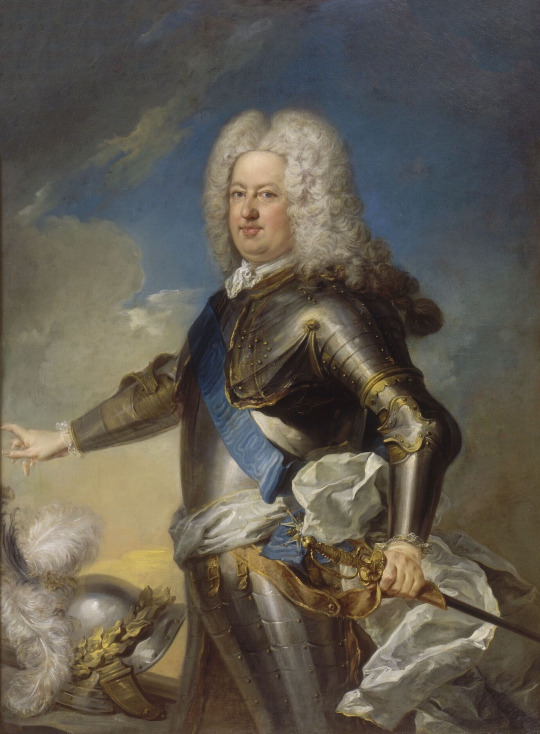
Portrait of Stanisław I Leszczyński. By Jean-Baptiste van Loo.
21 notes
·
View notes
Text

The children of King George I of Saxony and Infanta Maria Anna of Portugal, mids 1870s.
Prince Frederick Augustus, Prince Maximilian, Princess Mathilde, Princess Maria Josepha and Prince Johann Georg.
#king frederick augustus iii of Saxony#princess mathilde of saxony#princess maria josepha of saxony#prince johann georg of saxony#prince maximilian of saxony#german royalty#german royal#saxony#1870s#mids 1870s
12 notes
·
View notes
Photo
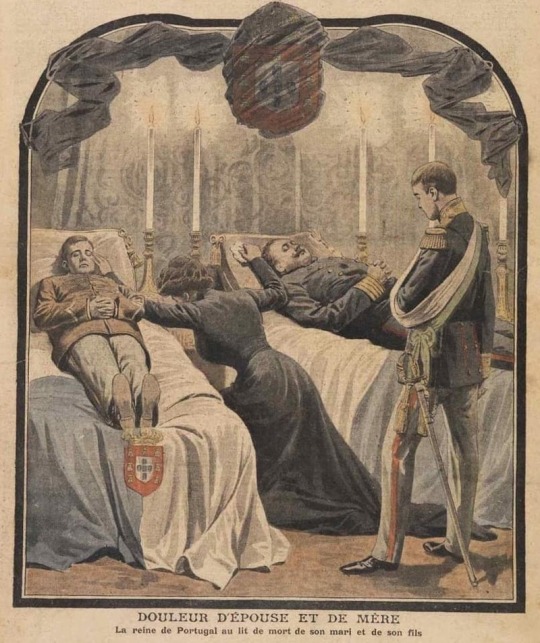
On February 1, 1908, the Portuguese royal family returned to Lisbon from a month-long holiday at Vila Viçosa. Disembarking from their train at Cais do Sodré station in central Lisbon, they boarded an open carriage for the last leg of their journey to the Queluz National Palace. While passing through the Praça do Comércio (Commerce Square), beside the Tagus River, they were ambushed by republican activists Manuel Buiça and Alfredo Costa. Armed with a rifle and pistol, respectively, they fired multiple shots into the the carriage, killing King Carlos I instantly, fatally wounding Prince Luis Filipe, striking Prince Manuel in the arm, and wounding the coachmen in one hand. Buiça also wounded a soldier, Henrique da Silva Valente, who intervened to spoil his aim. Only Queen Amélie of Orleans escaped injury, as police killed both assailants and an innocent bystander.
Born in Lisbon on September 28, 1863, the son of King Luis I and Queen Maria Pia of Savoy, Carlos Fernando Luis Maria Victor Miguel Rafael Gabriel Gonzaga Xavier Francisco de Assis José Simao boasted a roster of royal relatives including King Victor Emmanuel II of Italy, King Frederick Augustus III of Saxony, and King Ferdinand of Romania. Succeeding to the Portuguese throne upon his father's death, in October 1889, Carlos faced his first crisis three months later, with the British ultimatum of January 1890, breaching the 1386 Treaty of Windsor to dispute Portuguese territorial claims in Africa. Carlos signed the controversial Treaty of London in August 1890, relinquishing much of Angola and Mozambique, while furious protests errupted at home.
Chief among the protesters were leaders of the Portuguese Republican Party and the Carbonaria, a conspiratorial revolutionary society opposed to both the monarchy and the Catholic Church. Republicans won only 2.7 percent of the popular vote nationwide in 1906 – four seats in the National Assembly, all from Lisbon – but its support concentrated in the capital and in Porto, where party leader Bernardino Machado proclaimed, “We are the majority.” The Carbonaria, founded in 1896 by Artur Augusto Duarte de Luz de Almeida, prefered direct action to electioneering, organizing along military lines to recruit an estimated 40,000 members – including many frustrated republicans. Further agitation came from the Liberal Regenerator Party, organized by Joao Franco in 1901, and from Progressive Dissidence, founded by Jose Maria de Alpoim in 1905. Dissident parties battled one another, while condemning the monarchy for inefficiency and failure to support reform.
Carlos responded to that opposition by naming Joao Franco as prime minister in May 1906. Franco tried to form a coalition with Progressive Party leader and two-time former prime minister Jose Luciano de Castro, but failing there, he persuaded Carlos to suspend future elections until Franco deemed them practical, while jailing dissidents. Those moves predictably increased political tension, prompting Republican Party spokesman Alfons Costa to say that “for less than Dom Carlos has done, the head of Louis XVI fell.” Franco responded to increasing agitation with Costa's arrest, detention of 93 other republicans, and a ban on public meetings.
After the assassinations of February 1908, Prince Manuel was proclaimed king of Portugal. He proved to be the nations last monarch, deposed and exiled by a republican revolution in October 1910. Joao Franco was long gone by then, driven from office and from public life by successor Francisco Joaquim Ferreira do Amaral on February 4, 1908. A two-year investigation of the royal murders indicted several Carbonaria suspects on October 5, 1910, but they were spared from trial by a republican coup d'etat that deposed King Manuel II and established the First Portuguese Republic.
Famous Assassinations in World History: An Encyclopedia
#King Carlos I of Portugal#Queen Amelie of Portugal#Crown Prince Luis Filippe#King Manuel II#portuguese royal family#lisbon regicide#1900s
30 notes
·
View notes
Photo


The Royal Collection definitely frequently incorrectly labels things. For example, the record for Maria Theresa, the mother of Marie Antoinette, confuses her with her granddaughter of the same name and doesn’t seem to have a separate record for said granddaughter, they’re sort of mashed together.
This one though, THIS takes the proverbial cake.
Here’s the description of the above image:
An etching of Holy Roman Emperor Francis I and his family. Eight vignettes of Francis I alongside his wife and children, with plaques bearing the names of each sitter. The portraits are surrounded by allegorical figures above and a battle scene below with two female allegorical figures standing beside an orb, flags, drums and a canon. Beneath the image is a Latin inscription beginning 'Gens Germana gemens! ensem praeponderat ecce!...'
But looking at the image for literally a few seconds makes it VERY obvious that’s not what it is. Below it is a closeup of the figures in the image, and the inscriptions below them reveals it’s actually of different European Monarchs, and not the family of Francis and Maria Theresa.
Left to Right on the top we have:
Adolf Frederick, King of Sweden
Elizabeth, Empress of Russia
Francis I, Holy Roman Emperor
Maria Theresa, Holy Roman Empress, Queen of Bohemia, Hungary, and Croatia, Archduchess of Austria
Louis XV, King of France and Navarre
Augustus III, King of Poland and Elector of Saxony
Left to right below we have:
George II, King of England and Elector of Hanover
Frederick II, King of Prussia and Elector of Brandenburg
Is it a big deal in the grand scheme of things? No probably not. But you’d think having looked at the image, written a caption, and chosen to publish it, they’d have actually...you know...LOOKED at the image!
#the royal collection#maria theresa#francis i#louis xv#elizabeth of russia#king adolf frederick#augustus iii#george ii#frederick the great#long live the queue
11 notes
·
View notes
Photo

Archduchess Louise of Austria daughter of Ferdinand IV, the last Grand Duke of Tuscany and his second wife, Princess Alice of Bourbon-Parma, married to Frederick Augustus (III) member of the House of Wettin and the last King of Saxony. She is wearing the costume of Marie Antoinette of France.
31 notes
·
View notes
Text

King Frederick Augustus III of Saxony
German vintage postcard
#tarjeta#postkaart#sepia#king#carte postale#ansichtskarte#augustus#german#frederick augustus iii#briefkaart#saxony#photo#photography#postal#postkarte#frederick#vintage#postcard#historic#ephemera
1 note
·
View note
Text

Portrait of Augustus III of Poland
Artist: Louis de Silvestre (French, 1675–1760)
Date: After 1733
Medium: Oil on Canvas
Collection: The Wilanów Palace Museum, Warsaw, Poland
Augustus III of Poland
Augustus III (17 October 1696 – 5 October 1763) was King of Poland and Grand Duke of Lithuania from 1733 until 1763, as well as Elector of Saxony in the Holy Roman Empire where he was known as Frederick Augustus II.
#portrait#painting#oil on canvas#augustus iii of poland#polish king#louis de silvestre#french painter#europe#poland#18th century painting#uniform#cape#sash#wig#drapes
7 notes
·
View notes
Text
German States:
Prussia - Forced by defeat to sign Treaty of Tilsit (1807), losing a third of its land, capping army at 42,000. Also allowed French troops to Garrison. After defeat of Napoleon in Russia, Prussia joined the Sixth Coalition. Under Marshal Gebhard Leberecht von Blucher (neigh), fought in Battle of Waterloo.
Hanover - at least mildly complicated by the fact that George III (of England) was ruler of Hanover. Napoleon imposed Convention of the Elbe on them in 1803, with 35,000 french soldiers occupying Hanover, but George refused to recognize it. Many Hanoverian soldiers emigrated to England and joined George's King's German Legion, which took part in Waterloo.
Brunswick - Similar to Hanover, was owned by George III (of England) at least until the dissolution of the HRE by Napoleon. After the war, he regained his lands as the King of Hanover.
Bavaria - 1805 Peace of Pressburg raised Bavaria to status of Kingdom. Had to rely on Napoleonic France, however. War with Austria in 1808, and 1810 to 1814. Lost territory to Wurttemberg, Italy, and Austria. During Invasion of Russia, 30,000 Bavarian soldiers were killed. Joined Sixth Coalition in october 1813; declared war on Franc on Oct 14th. Ended campaign at the Battle of Leipzig.
Mecklenburg - apparently uninteresting. Thank you, Wikipedia.
Holstein - Became a sovereign state with dissolution of HRE in 1806. Personal union with Denmark, so did not come under French occupation.
Denmark - I say it counts b/c of personal union with Holstein. If it's good enough for Napoleon, it's good enough for me. Considered itself neutral, and so traded with both France and Britain. Jointed the League of Armed Neutrality (which is a great name), until its collapse after the assassination of Pavel I (of Russia) in 1801. The Brits were no impressed, and attacked Copenhagen in 1801 and 1807, (which I believe led to the only capture of a naval force by an army). The British successfully stopped trade through naval superiority and Denmark/Norway went bankrupt in 1813.
Saxony - Became a kingdom in 1806 with dissolution, etc. etc. King Frederick Augustus remained loyal to Napoleon. Taken prisoner and territories declared forfeit by allies in 1813 after defeat of Napoleon. Restored after shenanigans at Congress of Vienna.
2 notes
·
View notes
Photo

Archduchess Louise of Austria (2 September 1870 in Salzburg – 23 March 1947 in Brussels), was by marriage Crown Princess of Saxony as the wife of the future King Frederick Augustus III.
#Louise of Austria#House Habsburg-Lorraine#XX century#people#portrait#photo#photography#Black and White
9 notes
·
View notes
Text
King Pedro V’s 5th sibling: Infanta Maria Ana de Portugal

Born: 21st August 1843 Necessidades Palace, Lisbon, Portugal Died: 5th February 1884 (aged 40) Dresden, Saxony
Infanta Maria Ana of Portugal (Maria Ana Fernanda Leopoldina Micaela Rafaela Gabriela Carlota Antónia Júlia Vitória Praxedes Francisca de Assis Gonzaga) (21st August 1843 – 5th February 1884) was a Portuguese infanta (princess), the eldest surviving daughter of Queen Maria II of Portugal and her King consort Fernando II of Portugal, a member of the House of Bragança.
After her mother's death in 1853, when Maria Ana was just ten years old, she became the leading lady of the court, until her older brother, King Pedro V of Portugal, married Princess Stephanie of Hohenzollern-Sigmaringen,

in 1858. Although in the early stages of their acquaintance the two sisters-in-law had a good relationship, in a letter written in 1859 to Prince Albert of Saxe-Coburg and Gotha,

when Stephanie was already dead, King Pedro mentions that his sister made unflattering comments regarding his wife "because of her feminine vanity caused by a lower status (...)"
The relationship between the sisters-in-law seems to have had its ups and downs since Stephanie's arrival in May 1858 and Maria Ana's wedding in May 1859. The Queen wrote about her sister-in-law: "She is, in every respect, the one who is more like Pedro (...)", "She is a charming person, good, generous, remarkably sensible for her age, with no trace of selfishness, respected and loved by all of us (...) George of Saxony has discovered a true gem. She is happy and loves him, but she cannot talk about the moment in which she will leave her family without crying. What is certain is that she will leave a terrible emptiness behind". Maria Ana's brother, Pedro, also claims during this time that his sister is "the pearl of our family circle", in a letter to Prince Albert.
She married in Lisbon at the Belém Palace on 11th May 1859 Prince George of Saxony (1832–1904),

second son of King John I of Saxony,

a kinsman from the Catholic Albertine branch of her father's Wettin dynasty. Queen Stephanie tried to organize a brilliant ceremony, but, in the end, the wedding was quiet and went unnoticed in both Portugal and Saxony. The newly-weds spent their first days as a married couple at Belém Palace. During their short stay in Portugal after the ceremony, Prince George left a poor impression with the Portuguese Royal Family, as he "barely talked to the bride" and did not attend a theater performance to which he had been invited. During that same performance, 15-year-old Maria Ana was seen crying. The couple left to Saxony on May 14th. Maria Ana was not allowed to take Portuguese ladies-in-waiting with her and was only accompanied by her brother Luís
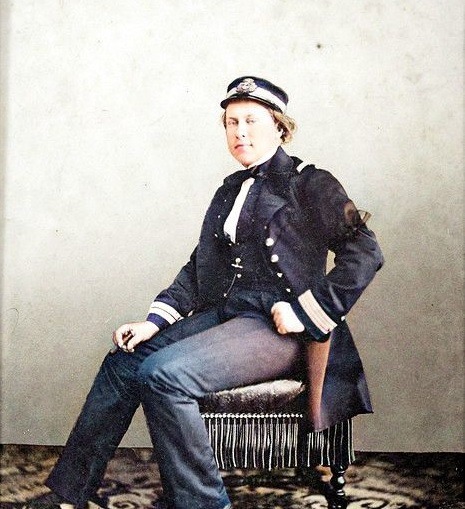
in the journey. Pedro V wrote the following regarding the wedding: "the wedding of my sister to Prince George of Saxony was celebrated with more pomp than happiness. The former is followed by a regretful fate, as he left no sympathies and people who met him often left with a poor impression."
The marriage was not a happy one, according to Historian Eduardo Nobre who claims that the Prince "did not live up to the expectations and qualities of the Portuguese Infanta". Despite their issues, they had eight children.
Although she renounced her claims to the Portuguese throne when she married, Maria Ana could still become Queen if the male line became extinct. This situation nearly happened in 1861, when King Pedro V and two of her other brothers died from Typhoid Fever and left no children. However, this hypothesis was completely put aside when her brother, King Luís I, married Princess Maria Pia of Savoy
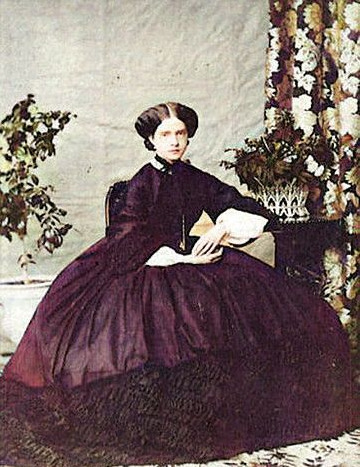
and had two sons, the future King Carlos I
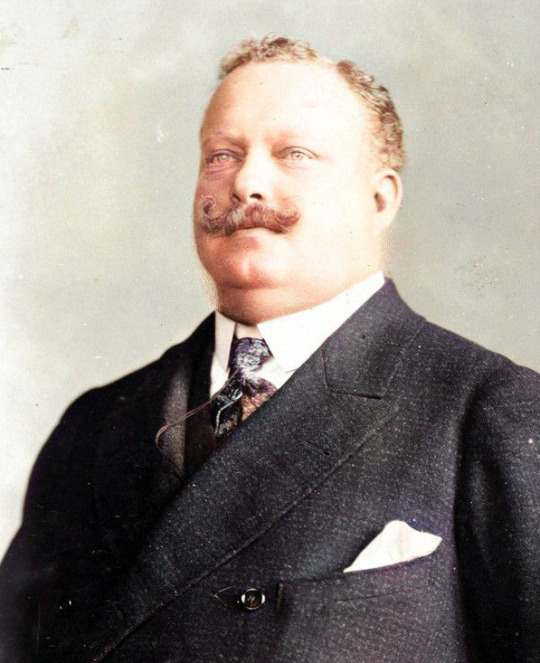
and Infante Afonso.
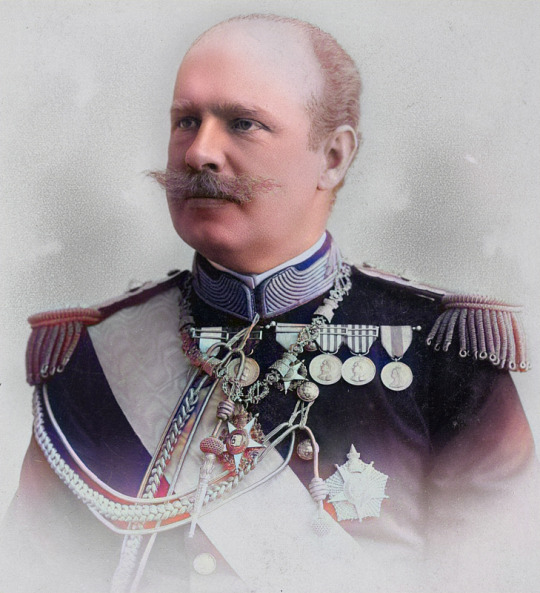
Despite everything, it's not likely that Maria Ana ever gave this hypothesis great importance because of her troubled marriage and many children.
Around 1883, her youngest son, Prince Albert of Saxony,

became seriously ill. Maria Ana took care of him for several months until he recovered. This effort would be fatal, as the Infanta died from exhaustion, on 5th February 1884, before her husband became King. Her husband would remain unmarried for the rest of his life.
In Portugal, her second brother Luís I soon succeeded her eldest brother Peter V as king.
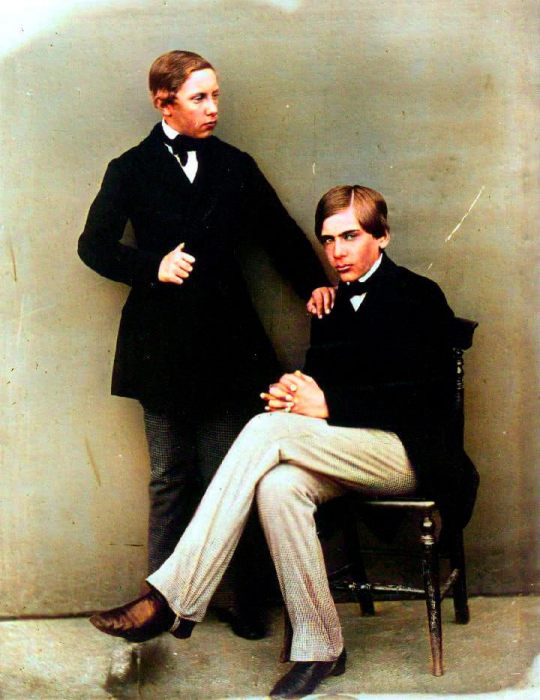
Her husband's elder brother Albert
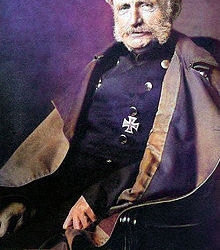
succeeded her father-in-law as King of Saxony and gradually it became clear that he and his wife Carola of Vasa
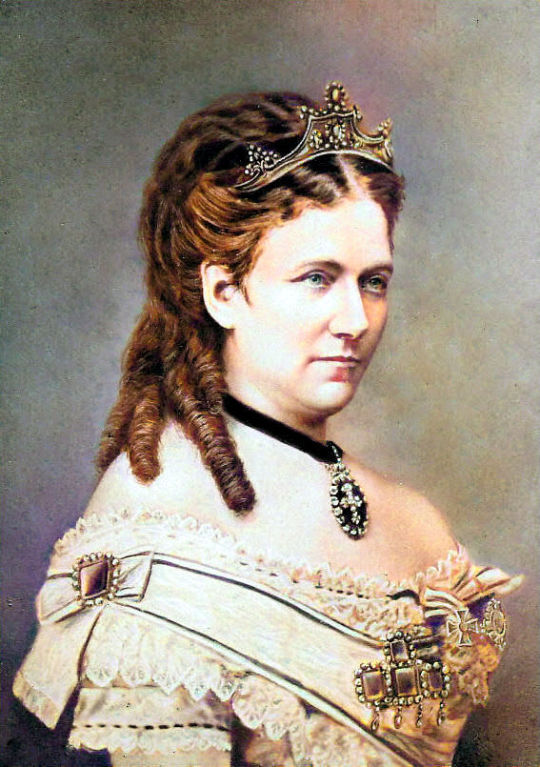
were not able to have children of their own. Maria Ana's eldest son would almost certain to one day succeed to the throne.
Marie Johanna Amalie Ferdinande Antonie Luise Juliane, (19th June 1860 - 2nd March 1861), died in childhood, no issue
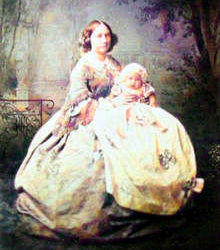
Elisabeth Albertine Karoline Sidonie Ferdinande Leopoldine Antonie Auguste Clementine (14th February 1862 - 18th May 1863) died in childhood, no issue
Mathilde Marie Auguste Viktorie Leopoldine Karoline Luise Franziska Josepha (19th March 1863 - 27th March 1933) died unmarried, no issue
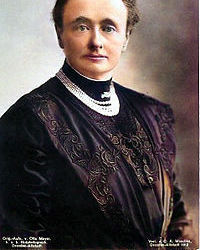
Frederick Augustus Johann Ludwig Karl Gustav Gregor Philipp (25th May 1865 - 18th February 1932)
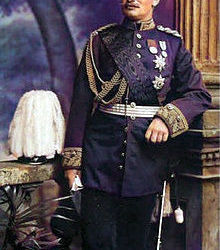
married Princess Louise of Tuscany (1870–1947),
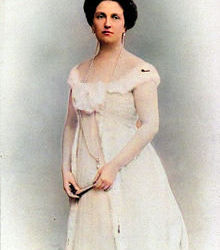
later divorced, had issue
Maria Josepha Luise Philippine Elisabeth Pia Angelica Margarethe (31st May 1867 - 28th May 1944)

married to her cousin second degrees Archduke Otto Franz of Austria (1865–1906),
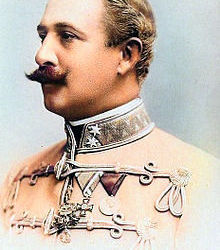
had issue
Johann Georg Pius Karl Leopold Maria Januarius Anacletus (10th July 1869 - 24th November 1938) married first Duchess Maria Isabella of Württemberg (1871–1904) and second Princess Maria Immaculata of Bourbon-Two Sicilies (1874–1906)

Maximilian Wilhelm August Albert Karl Gregor Odo (17th November 1870 - 12th January 1951) ordained as a priest, died unmarried, no issue
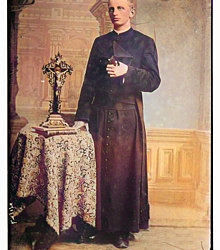
Albert Karl Anton Ludwig Wilhelm Viktor (25th February 1875 - 16 September 1900) died unmarried, no issue.

Princess Maria Ana predeceased her father Fernando, her husband George, and her brother-in-law King Albert of Saxony. In 1902 George succeeded his childless brother as king, and on his death in 1904 Maria Ana's eldest son became King of Saxony as Frederick Augustus III.
#infanta maria ana de bragança#house of bragança#queen maria ii of portugal#king consort fernando ii#king pedro v of portugal
13 notes
·
View notes
Photo





AN 1892 MODEL ARTILLERY OFFICER'S SABRE Curved, single-edged blade with jelman, the base engraved and gilded with monogram "FAR" for king Frederick Augustus III (1904 - 1918), Saxon coat of arms and floral motifs. Mark "W.K & C" e "EISENHAUER". Gilded, brass hilt with crossed cannons, Saxon coat-of-arms on the loop-guard and pommel shaped as lion's head. Wooden grip covered with fish skin with metallic wire binding. Blackened scabbard (scratched) with one suspension ring. Saxony, first quarter of the 20th Century length 94 cm. © CZERNY’S INTERNATIONAL AUCTION HOUSE S.r.l.
28 notes
·
View notes